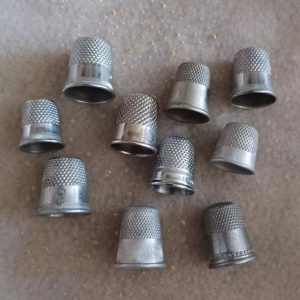The History, Usage, and Legacy of Vintage Sewing Thimbles
History
Thimbles have a long history dating back to ancient times. Archaeologists discovered the earliest known thimbles in the ruins of Pompeii, dating to the 1st century AD. Made of bronze, these simple yet functional tools protected fingers while sewing.
In medieval Europe, craftsmen made thimbles from leather, wood, and metal. By the 14th century, Nuremberg, Germany, became a key center for brass thimble production. The 17th century saw advancements in thimble design, with silver and gold thimbles becoming popular among the wealthy, serving as both practical tools and status symbols.

The 19th-century Industrial Revolution transformed thimble production. Factories produced thimbles efficiently and in large quantities, making them accessible to the general population. During this time, decorative and collectible thimbles adorned with intricate designs, engravings, and gemstones became fashionable.
Usage
A thimble’s primary function is to protect fingers from needle pricks while sewing. Typically worn on the middle finger, it allows sewers to push needles through fabric with greater force and precision, especially with tough materials.
Beyond sewing, people used thimbles in various crafts and trades, including bookbinding, leatherworking, and lace-making.
Thimbles also appear in popular culture and folklore. In the classic board game Monopoly, one of the original game pieces is a thimble, reflecting its common presence in early 20th-century households. In literature, such as in “Peter Pan,” a thimble symbolizes a kiss.
Legacy
Today, collectors and enthusiasts highly seek vintage thimbles. Their historical significance, varied designs, and craftsmanship make them prized artifacts. Collectors often seek thimbles from specific periods or made from particular materials like porcelain, bone china, or sterling silver.
Museums and exhibitions preserve the legacy of thimbles. For example, the Fingerhut Museum in Creglingen, Germany, showcases thousands of thimbles from different eras and regions.
Thimbles continue to inspire modern artisans and crafters, who appreciate their utility and aesthetic value. Contemporary thimble makers blend traditional techniques with modern designs, honoring the thimble’s rich heritage while appealing to today’s tastes.
In conclusion, vintage sewing thimbles are more than practical tools; they are historical artifacts reflecting the evolution of craftsmanship, social status, and cultural practices over centuries. Their enduring legacy underscores their importance in sewing history and their continued appreciation as collectible items.





